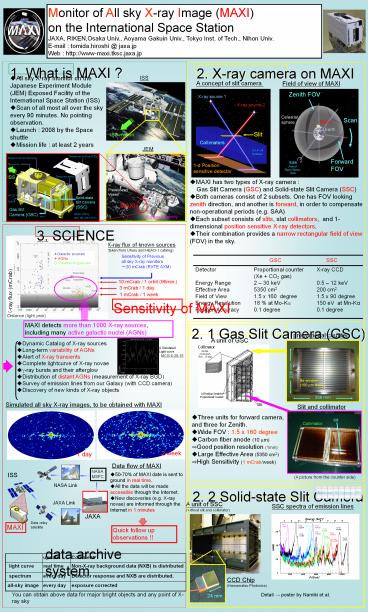Monitor of All sky X-ray Image (MAXI) - PowerPoint PPT Presentation
1 / 1
Title:
Monitor of All sky X-ray Image (MAXI)
Description:
... sensitive X-ray detectors. ... Gas Slit Camera (GSC) Pressurized Vessel MAXI Exposed Facility 3. SCIENCE Sensitivity of Previous all sky X-ray monitors 20 ... – PowerPoint PPT presentation
Number of Views:56
Avg rating:3.0/5.0
Title: Monitor of All sky X-ray Image (MAXI)
1
Monitor of All sky X-ray Image (MAXI) on the
International Space Station JAXA, RIKEN,Osaka
Univ., Aoyama Gakuin Univ., Tokyo Inst. of Tech.,
Nihon Univ. E-mail tomida.hiroshi _at_ jaxa.jp Web
http//www-maxi.tksc.jaxa.jp
1. What is MAXI ?
2. X-ray camera on MAXI
- All sky X-ray monitor on the Japanese Experiment
Module (JEM) Exposed Facility of the
International Space Station (ISS) - Scan of all most all over the sky every 90
minutes. No pointing observation. - Launch 2008 by the Space shuttle
- Mission life at least 2 years
ISS
A concept of slit camera
Field of view of MAXI
ISS motion
JEM
ISS
- MAXI has two types of X-ray camera
- Gas Slit Camera (GSC) and Solid-state Slit
Camera (SSC) - Both cameras consist of 2 subsets. One has FOV
looking zenith direction, and another is forward,
in order to compensate non-operational periods
(e.g. SAA) - Each subset consists of slits, slat collimators,
and 1-dimensional position sensitive X-ray
detectors. - Their combination provides a narrow rectangular
field of view (FOV) in the sky.
Pressurized Vessel
MAXI
Exposed Facility
3. SCIENCE
X-ray flux of known sources (taken from Uhuru and
HEAO-1 catalog)
Galactic sources AGNs ? Clusters of galaxies
X-ray flux (mCrab)
10 mCrab / 1 orbit (96min.)
3 mCrab / 1 day
1 mCrab / 1 week
Sensitivity of MAXI
Distance (light year)
MAXI detects more than 1000 X-ray sources,
including many active galactic nuclei (AGNs)
2. 1 Gas Slit Camera (GSC)
proportional counter
A unit of GSC
- Dynamic Catalog of X-ray sources
- Long-term variability of AGNs
- Alert of X-ray transients
- Complete lightcurve of X-ray novae
- g-ray bursts and their afterglow
- Distribution of distant AGNs (measurement of
X-ray BGD) - Survey of emission lines from our Galaxy (with
CCD camera) - Discovery of new kinds of X-ray objects
A Simulated Light curve MCG 6-30-15
Simulated all sky X-ray images, to be obtained
with MAXI
Slit and collimator
- Three units for forward camera, and three for
Zenith. - Wide FOV 1.5 x 160 degree
- Carbon fiber anode (10 mm)
- ?Good position resolution (1mm)
- Large Effective Area (5350 cm2)
- ?High Sensitivity (1 mCrab/week)
Slit
Collimator
2 week
1 day
Data flow of MAXI
NASA MSFC
- 50-70 of MAXI date is sent to ground in real
time. - All the data will be made accessible through the
Internet. - New discoveries (e.g. X-ray novae) are informed
through the Internet in 1 minutes
ISS
(A picture from the counter side)
NASA Link
2. 2 Solid-state Slit Camera (SSC)
JAXA Link
A unit of SSC (without slit and collimator)
SSC spectra of emission lines
JAXA
Data relay satellite
MAXI
Al-Ka 1.4876
Ti-Ka 4.51084
Cl-Ka 2.62239
V-Ka 4.95220
Quick follow up observations !!
Zn-Ka 8.63886
Fe-Ka 6.4038
V-Kb 5.42729
Ni-Ka 7.47815
Cl-Kb 2.8156
Fe-Kb 7.05798
Zn-Kb 9.5720
Ni-Kb 8.26466
data archive system
update Comment
light curve real time Non-X-ray background data (NXB) is distributed
spectrum every day Detector response and NXB are distributed.
all-sky image every day exposure corrected
CCD Chip (Hamamatsu Photonics)
You can obtain above data for major bright
objects and any point of X-ray sky
Detail ? poster by Namiki et al.
24 mm































